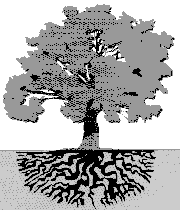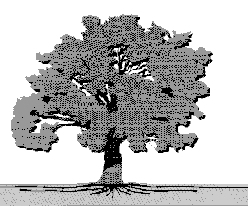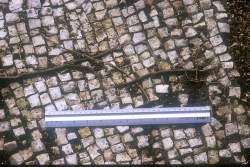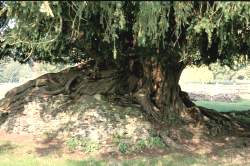Tree cover inevitably complicates both archaeological surveys and excavations and this combined with other priorities for rescue archaeology has resulted in relatively fewer studies in wooded areas compared to other rural environments. Therefore, published observations of root occurrence during archaeological excavations are rare, and a systematic recording of their presence, extent and impact would be advantageous in interpreting their impacts.
Typical rooting habit
A tree’s root distribution can be extensive and inevitably buried archaeological evidence located close to the soil surface can be at risk, depending on factors such as the type of evidence, soil, tree species, age, stand density and management. However, a common misconception regarding tree root structure is that their volume and distribution reflect that of the trunk and branches:

Instead, trees typically have relatively shallow but wide-spread root systems:

It is unusual for roots to penetrate to a depth greater than 2 m, with 80-90 % of the widespread rooting structure to be found within the top 0.6 m of the soil profile. Although few roots extend beyond 1-1.5 m depth, archaeological evidence commonly occurs within this soil thickness, and where important remains are known to exist close to the soil surface, tree planting is not recommended.
Factors influencing rooting habit
Whilst some species-specific rooting characteristics (genetic) exist, the primary influences on root distribution are those of silvicultural and soil conditions (environmental).
Trees require water for growth, but few roots are able to grow in permanently saturated horizons. Waterlogged soil results in poor gas exchange thus depleting the root of oxygen, which will lead to anaerobic conditions and eventually death. Thus a high water table will produce a shallow rooting system.
Roots are also unable to penetrate deeply into soils that are highly compacted, for example materials with excessive stoniness, fine sands, ironpans and many types of clay. Typically, soils become denser and less oxygenated with increasing depth, and soil conditions for root penetration are usually most suitable in the surface horizons.
Do roots “seek out” archaeological deposits?
Some buried archaeological features have a high nutrient content and constitute an attractive environment for biological activity. Under favourable environmental conditions, these can be exploited by soil fauna and plant roots, and subjected to physical homogenisation or chemical alteration. Hydrotropism is the process by which a root will grow towards a water supply. However, no similar process is known whereby roots actively seek out nutrient-rich deposits.
If a root encounters an archaeological deposit during normal growth, the extent of proliferation and exploitation will depend upon its nutrient and moisture content, and how that compares with the surrounding soil. Any water-retaining or nutrient-rich archaeological evidence in a drier or impoverished soil will provide a favourable rooting environment for any plant species.
Physical root interactions with archaeological materials
Small buried objects can be physically displaced by roots and worked flints have been found embedded within a growing root and moved from its original context. When a root encounters larger remains such as masonry, it will attempt to grow around it. If holes are found (e.g. in a dry stone wall foundation), the roots may penetrate the gaps. Roots will grow along the path of least resistance and this can be clearly seen in the figure below, where the roots of a hawthorn have grown between the individual tesserae of a mosaic floor. However, if the roots thicken, they may lift individual tiles:

The next picture shows a yew tree that has grown over a section of ruined wall. Adjacent wall is lower and it may be argued that the tree roots have protected and increased the wall’s stability resulting in its greater height under the trunk. However, should the tree be uprooted, physical damage to the wall is likely to be severe. With careful management to reduce the risk of windthrow, the yew should continue to coexist with the wall for many years.

Had the wall in the example above been much taller or the species of tree different, this section of wall may not still be standing. Trees can naturally seed onto buildings and ruins and where any soil or similar growing medium has begun to accumulate, they may begin to germinate. In most cases, there is unlikely to be sufficient moisture retained throughout the year in such a growing medium to sustain a tree and death will usually result with little or no damage to the archaeological feature. Where a thick wall contains a central fill of irregular stones, sufficient moisture retaining deposits may occur and gaps may facilitate root growth to the ground. Equally, lower walls may allow roots to quickly reach the soil over the outside. Where trees become established on a building or ruin, there will eventually be a risk of instability leading to possible damage to the feature and personal injury to the public. To prevent both, young trees and woody shrubs would usually be removed by cutting before the risks of instability become too great.
Root barriers
In some parts of the construction industry, physical barriers are placed underground to impede root growth and to reduce the risk of clay soil shrinkage caused by drying. Similar protection has been considered for archaeological sites, but the use of root barriers has met with mixed success.
Installation of any membrane would require significant ground disturbance, a process undesirable to any site of archaeological interest. The durability of buried barriers is also uncertain and those that do carry guarantees against degradation are for 20 to 30 years, considerably less that the lifespan of either trees or archaeological evidence.
